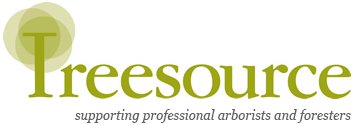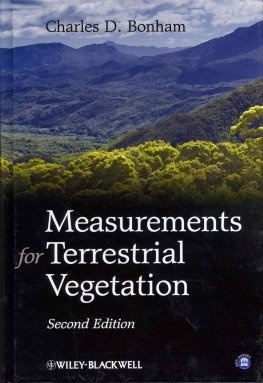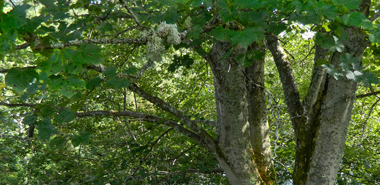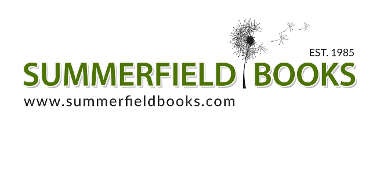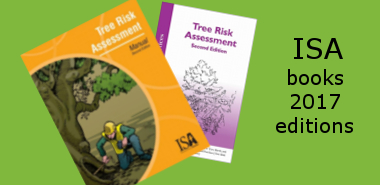| Hardback | |
| 260 Pages | |
| 171 x 246 x 18mm |
Measurements for Terrestrial Vegetation, 2nd Edition
£39.95Measurements for Terrestrial Vegetation, 2nd Edition presents up-to-date methods for analyzing species frequency, plant cover, density and biomass data. Each method is presented in detail with a full discussion of its strengths and weaknesses from field applications through statistical characteristics of bias and use of the correct probability distribution to describe and analyze data. This practical book also covers the use of satellite imagery to obtain measurement data on cover, density and biomass. Field data collection includes current applications of statistical sampling and analysis designs that should be used to obtain and analyze these data.
This new and thoroughly updated edition of a classic text will be essential reading for everyone involved in measuring and assessing vegetation and plant biomass, including researchers and practitioners in vegetation science, plant ecology, forestry, global change scientists and conservation scientists
Reviews
Preface xi
About the companion website xiii
1 Introduction 1
1.1 Historical brief 2
1.2 Units of measure 4
1.3 Choice of method 6
1.3.1 Vegetation characteristics 6
1.3.2 Biometrics and econometrics 7
1.4 Variation in vegetation 8
1.5 Observational units 9
1.6 Sampling 9
1.7 Frequency 10
1.8 Cover 11
1.9 Density 12
1.10 Biomass 13
1.11 Measurements with remote sensing 14
1.12 Monitoring and evaluation 14
1.13 Overview and summary 15
1.14 Bibliography 17
2 Sampling units for measurements 19
2.1 Frequency 20
2.2 Cover 20
2.2.1 Points 21
2.2.2 Point frames 21
2.2.3 Point line 22
2.2.4 Grid quadrats 23
2.2.5 Line intercept 24
2.2.6 Areas 24
2.2.7 Plotless units 25
2.3 Density 29
2.3.1 Plot size 29
2.3.2 Shape of plots 29
2.3.3 Line transects 30
2.3.4 Distance methods 31
2.4 Biomass 31
2.4.1 Plot characteristics 32
2.4.2 Indirect methods 34
2.5 Tree measurements 35
2.5.1 Tree heights 35
2.5.2 Units of measure for tree diameters 37
2.5.3 Tree crown cover 40
2.6 Bibliography 41
3 Statistical concepts for field sampling 43
3.1 Characterization of data 44
3.1.1 Measures of data location 45
3.1.2 Measures of dispersion 48
3.2 Principles of data behavior 52
3.2.1 Patterns of data commonly observed 52
3.2.2 The normal distribution 53
3.2.3 Sample statistics and the normal distribution 55
3.2.4 Confidence limits 59
3.3 Sample size 59
3.3.1 When available budget is too small 62
3.3.2 Sample size for non-normal data 63
3.4 Data distributions 63
3.4.1 Bernoulli data distribution 64
3.4.2 Geometric data distribution 67
3.4.3 Pascal data distribution 67
3.4.4 Negative binomial data distribution 68
3.4.5 Binomial data distribution 69
3.4.6 Poisson data distribution 71
3.5 Bibliography 73
4 Spatial sampling designs for measurements 75
4.1 Simple random sampling 77
4.2 Cluster and systematic sampling 78
4.3 Two-stage sampling design 80
4.4 A role for satellite imagery 81
4.4.1 Sampling units 83
4.4.2 Spatial sampling 85
4.4.3 Studies of large areas 86
4.5 On-ground large-scale spatial analyses 89
4.6 Bibliography 95
5 Frequency 99
5.1 Brief history and definition 99
5.2 Estimates of frequency 101
5.2.1 Influences of size and shape of the plot 103
5.2.2 Requirements for valid comparisons 104
5.3 Minimal area and frequency 104
5.4 Plot size considerations 105
5.5 Applications for frequency data 112
5.5.1 Prediction and monitoring 112
5.6 Considerations 114
5.7 Bibliography 115
6 Cover 117
6.1 Basal area techniques 118
6.1.1 Diameter rule 119
6.2 Intercept techniques 120
6.2.1 Point intercept 120
6.2.2 Grid-quadrat frame 121
6.2.3 Vertical point frame 123
6.2.4 Horizontal point frame 123
6.2.5 Single points 125
6.3 Line-intercept methods 130
6.4 Crown diameter and canopy closure method 138
6.5 Variable plot methods 139
6.6 Semi-quantitative methods 141
6.7 Bibliography 148
7 Density 153
7.1 Related measurements 153
7.1.1 Frequency 153
7.1.2 Abundance 154
7.2 Limitations of the density estimate 155
7.3 Quadrat techniques 156
7.3.1 Distribution 156
7.3.2 Quadrat size and shape 158
7.3.3 Strip or rectangular quadrats 160
7.3.4 Considerations 161
7.4 Distance methods 161
7.4.1 Random populations 163
7.4.2 Distance methods for random and non-random populations 166
7.5 Line transect 169
7.6 Comments 171
7.7 Bibliography 172
8 Biomass 175
8.1 Herbaceous biomass 175
8.1.1 Harvesting 175
8.1.2 Measurement of biomass 176
8.1.3 Non-destructive methods 179
8.1.4 Productivity 185
8.1.5 Considerations of herbaceous biomass sampling 186
8.2 Shrub biomass 189
8.2.1 Non-destructive methods of shrub biomass 189
8.2.2 Considerations of shrub biomass sampling 200
8.3 Forest biomass 201
8.3.1 Regression models of biomass estimation 202
8.3.2 Bark biomass 203
8.4 Tree foliage biomass 204
8.5 Considerations for tree biomass sampling 207
8.5.1 Annual production of tree foliage 207
8.5.2 Production of tree biomass 208
8.6 Selection of sampling units for tree biomass 209
8.6.1 Sampling procedures 210
8.7 Bibliography 212
9 Monitoring and evaluation 217
9.1 Mapping units 218
9.1.1 Conventional mapping 219
9.1.2 Satellite imagery mapping 219
9.1.3 Naming vegetation units 220
9.1.4 Describing vegetation units 221
9.2 Basic considerations 221
9.3 Sampling and monitoring vegetation 223
9.3.1 Individual plant approach 224
9.3.2 Multispecies approach 225
9.4 Selection of a monitoring procedure 225
9.4.1 Vegetation measurements 225
9.4.2 Spectral imagery techniques 226
9.4.3 Weight estimate methods 226
9.5 Models versus measurements for monitoring 227
9.6 Case studies for remote sensing 228
9.7 Plant species evaluations 231
9.7.1 Plant association 231
9.7.2 Diversity indices 233
9.8 Bibliography 234
Appendix Unit conversion tables 237
Index 239
Publisher: - Wiley-Blackwell - more
Code: - 9780470972588
Year: - 2013 05 (May)
Authors: - Charles D. Bonham
